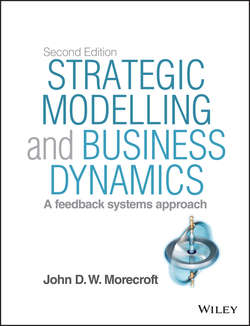Читать книгу Strategic Modelling and Business Dynamics - Morecroft John D. - Страница 6
На сайте Литреса книга снята с продажи.
Foreword by Peter Checkland
ОглавлениеWhen I was a manager in the synthetic fibre industry in the 1950s and 60s, there was a recognised but problematical pattern of activity in the textile industry. A small increase in demand for textile products would induce big ups and downs back in yarn and fabric production. This arose as a result of the structure of the production-to-retail chain, a sequence from fibre to yarn to fabric to products, these being stages in the hands of different companies between which were time delays. This recurring pattern of response to demand change was one which no one stakeholder could command and control.
Many areas of human activity reveal dynamics of this type, with several classic patterns of behaviour: exponential growth or decline; oscillation; S-shaped growth; growth followed by collapse, etc.
John Morecroft's textbook is a brilliantly clear guide to elucidating and modelling such patterns of behaviour. The modelling is normally a team effort based on both real-world experience of the area and the principles of system dynamics. Such modelling seeks to reveal enduring feedback structures (both balancing and reinforcing) which are real characteristics of the situation in question but are normally hidden. Once developed, such models are ‘instruments for investigation, clarification and discovery’, and can be used to feed better evidence into discussion of strategy than does the reliance on experience and gut feel, which is the common mode of managing.
These pictures of dynamic behaviour may be relevant within an organisation (public or private) or may be characteristic of an industry. A particularly interesting example in the book is the one which in the end affects us all – the dynamics of the oil industry. Here is complexity stemming from an oil market which tries to meet demand, a fluctuating price for oil, an organisation of some producers (OPEC) which sets quotas for production and suppliers consisting of independents, opportunists and a ‘swing producer’ (Saudi Arabia), which produces just enough to defend OPEC's intended price. The build-up of the model of industry dynamics is lucidly described. It was carried out not as an academic exercise but by the author working with a team of Shell managers, and made a serious contribution to Shell's strategic thinking about their industry context and its possible futures.
This illustrates an outstanding feature of John Morecroft's approach. All the work described was carried out in active engagement with managers facing problems.
Not for this author the too-familiar picture in which academics sit at their desks and write papers about other papers!
So this book is not ‘academic’ in the usual derogatory sense of that word. Nor is it a book to be read casually in an armchair, for it comes with website materials enabling readers to get a feel for situation dynamics by running simulators – including one containing the oil industry model.
Finally, although presented as a textbook, this volume is relevant on a broader canvas. When I was a manager in industry I found the then textbook management science irrelevant to my day-to-day concerns. However, since then a major shift in perspective has occurred. Originally the core concept (‘hard’) was to make models of assumed real-world systems, and then experiment on the models to find optimum ways of doing things. The richer current concept (‘soft’) illustrated here, is complementary to this. It uses models as transitional objects to aid learning. In his last chapter John Morecroft writes:
The idea that there is a singular and objective world out there to be modelled is replaced with the softer notion that a formal model can help improve mental models … through which we interpret and make sense of the world …
For its lucidity, its practicality and its illustrations of the idea of consciously learning your way to ‘action to improve’, this book is a very welcome addition to the literature. It brings a fresh wind off the heath to the groves of academe.
Peter Checkland
Emeritus Professor of Systems
and Honorary Fellow
of Lancaster University
